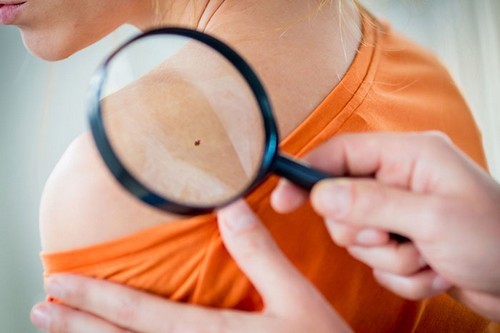Moles are found in almost all people over 10 years old, and there is no place on the body where they could not appear. The formation of new moles and the disappearance of those already familiar are usually of concern. So what do we call moles, in which cases can you do just consult a dermatologist, and when do you need to remove them?
A mole (or in Latin – nevus) is a pigmented, usually benign skin tumor, or tumor. It is formed from skin cells – melanocytes, which produce the dark pigment melanin.
The appearance of the nevus depends on the depth of melanocytes. If they are located close to the surface, the neoplasm will be in color from dark brown to black, flush with the skin or slightly above it.
This is usually not a concern. If pigment cells are located in the deep layers of the skin, the mole is light and rises significantly above the surface, since much more melanocytes participate in its formation. Such nevi, as well as moles larger than 5 mm, should be shown to a dermatologist at least once a year, because there is a risk of their degeneration into malignant tumors (melanoma – skin cancer).
Influence factors
Moles are congenital and acquired. They appear and disappear throughout life. Over time, the nevi can gradually change shape, size, lighten or darken. This is the norm. The main thing is that in six months the neoplasm should increase by no more than 5 mm, and the color should remain uniform. Moles can be activated by genetic factors, sunlight, endocrine changes, and due to trauma.
People genetically predisposed to the formation of moles, it is better at least once a year to see a dermatologist. This is especially true for those who have a lot of nevi. Indeed, in this case, tracking their behavior is more difficult, and the risk of degeneration is higher.
Hair on moles, so as not to injure the nevus, it is better not to tear, but to cut.

To reduce the influence of the sun, you need to use sunscreens. The lighter the skin, the higher the protection factor should be. You need to sunbathe before 10 hours and after 16 hours, when the sun is not so active. This is especially important for fair-skinned and fair-haired people, pregnant, freckled, and those who have many moles.
Moles can also change under the influence of hormones that the pituitary gland produces at 3 years old, at 6 years old, during puberty, pregnancy and menopause.
Injury can cause infection or deformity of the nevus, which is very dangerous. After all, the body, trying to restore the damaged place, begins to produce new pigment cells. How they behave is difficult to predict.
Attention Area
A symptom of a dysfunction may be a sharp change in the color of the nevus, a violation or complete absence of a skin pattern, peeling or redness that has arisen around it, blurred outlines and densification of a mole. Neoplasms that are dark, with a “lacquered” surface and sharply detached from the skin surface should also be shown to specialists because of the risk of their transformation into malignant tumors.
The exact address
Categorically it is impossible to remove nevi in beauty salons at the ordinary cosmetologist. As a rule, this is a person with secondary medical education, which means that he will not be able to make a diagnosis and choose the correct method of removal. In addition, in this case, histological examination is excluded.
Visit to the doctor
The first step to resolving doubts is to visit a dermatologist. Very often, after examination, he sends the patient to an oncologist. Do not worry: this is a common medical practice. Sometimes it is impossible to make an accurate diagnosis right away, because there are borderline moles, and it’s difficult to immediately figure out whether it is melanoma or not.
The oncologist recommends removing the mole or coming back for an examination in six months to a year. Be sure to get rid of the nevi located in traumatic places – on the scalp, groin, mucous membranes, perineum, inner thighs, sole, etc. The removal method depends on the diagnosis.
A dermatologist deals with superficial nevi; an oncologist deals with dubious and deep ones. In any case, the nevus is sent for histological examination. In 90% of cases, it dispels all fears and recognizes a mole as benign.



